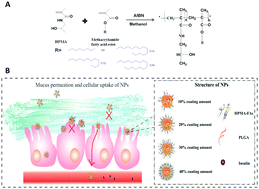A strategy for developing effective orally-delivered nanoparticles through modulation of the surface “hydrophilicity/hydrophobicity balance”†
Abstract
Efficient oral delivery of macromolecules by nanoparticles is greatly limited by epithelial cells and the mucus layer that covers the surface of the intestinal epithelium. Worse still, to overcome both the mucus and epithelium barriers, opposite surface properties of the nanocarriers are required. Hydrophilic properties are necessary for mucus permeation, while hydrophobic ones are preferable for epithelium internalization. Thus, it is supposed that there must be a balance between the hydrophilicity and hydrophobicity of the surface of nanoparticles (NPs), which would provide NPs with a rapid mucus penetrating ability and satisfactory cellular uptake efficiency. In the current study, we have synthesized a series of copolymers (HPMA–FAs) composed of hydrophilic N-(2-hydroxypropyl) methacrylamide (HPMA) and four hydrophobic methacrylamido fatty acid ester (FA) analogues. By changing the amount of HPMA–octyl methacrylate (HPMA–C8) or applying different FAs on polymerization of the HPMA–FA copolymers for the NP formulation, we have formulated NPs with varied surface hydrophilicity/hydrophobicity properties. It was observed that the NPs coated with a 20% amount of the HPMA–C8 copolymers could result in a satisfactory mucus penetrating ability and cellular uptake efficiency, while the NPs coated with a 20% amount of the HPMA–cetyl methacrylate copolymer (NPs-C16 (20%)) presented the best results compared with the other HPMA–FA formulated NPs. The in vivo study showed that insulin-loaded NPs-C16 (20%) generated an obvious hypoglycemic effect, with a maximal 46% reduction of the blood glucose level. Moreover, no histopathology lesions or serum chemistry parameter changes were observed based on the in vivo toxicity test. Therefore, we hope that these results will provide a new perspective for the design of mucus-penetrating and epithelium-absorbed NPs for oral drug delivery systems.



 Please wait while we load your content...
Please wait while we load your content...